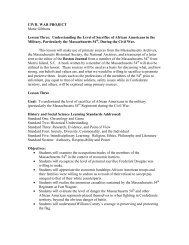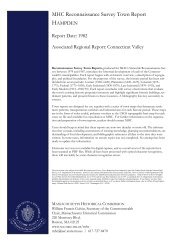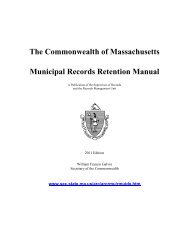Roads, Rails, and Trails - Secretary of the Commonwealth
Roads, Rails, and Trails - Secretary of the Commonwealth
Roads, Rails, and Trails - Secretary of the Commonwealth
Create successful ePaper yourself
Turn your PDF publications into a flip-book with our unique Google optimized e-Paper software.
The iron industry was one <strong>of</strong> <strong>the</strong> very first kinds <strong>of</strong><br />
manufacturing established in <strong>the</strong> American colonies. The<br />
colonists needed iron tools, pots, nails, <strong>and</strong> o<strong>the</strong>r hardware in<br />
order to build homes <strong>and</strong> cultivate crops. Massachusetts had<br />
vast forests, which could supply charcoal—a key ingredient in<br />
smelting, refining, <strong>and</strong> forging—as well as a supply <strong>of</strong> “bog<br />
iron”—iron oxide deposits that formed in wetl<strong>and</strong>s. The<br />
English iron industry, by contrast, was limited by its dwindling<br />
forests. The Saugus Ironworks, located a short distance north<br />
<strong>of</strong> Boston, began operating in 1646 <strong>and</strong> produced cast iron as<br />
well as more refined wrought iron on an impressive scale until<br />
<strong>the</strong> 1670s. A working reconstruction <strong>of</strong> this pioneering factory<br />
complex based on archaeological excavations (as well as <strong>the</strong><br />
original slag pile) is run by <strong>the</strong> National Park Service <strong>and</strong> is<br />
open to <strong>the</strong> public.<br />
After Saugus closed, smaller iron foundries grew up to<br />
serve local <strong>and</strong> regional markets for cast <strong>and</strong> wrought iron.<br />
Sou<strong>the</strong>astern Massachusetts, with its many bogs <strong>and</strong> acres <strong>of</strong><br />
forest, became known for its foundries. The development <strong>of</strong><br />
cast iron stoves in <strong>the</strong> 1700s was a fur<strong>the</strong>r stimulus to <strong>the</strong><br />
industry. The growing American iron industry worried <strong>the</strong><br />
English government, which attempted to stifle this growth by<br />
passing <strong>the</strong> Iron Act in 1750; but it was not strictly observed.<br />
With independence came fur<strong>the</strong>r growth to meet <strong>the</strong> needs <strong>of</strong><br />
<strong>the</strong> public as well as <strong>the</strong> military. The Highl<strong>and</strong> Foundry was<br />
part <strong>of</strong> New Engl<strong>and</strong>’s great nineteenth-century industrial<br />
expansion. The Highl<strong>and</strong> Foundry provides an example <strong>of</strong> a<br />
foundry in an urban environment, where industry, housing, <strong>and</strong><br />
transportation grew <strong>and</strong> affected one ano<strong>the</strong>r. The dramatic<br />
growth <strong>of</strong> industry in <strong>the</strong> nineteenth century is rightly termed a<br />
“revolution” because it revolutionized <strong>the</strong> ways people worked,<br />
lived, <strong>and</strong> consumed. The Highl<strong>and</strong> Foundry was a part <strong>of</strong> that.<br />
39<br />
Today’s urban setting <strong>of</strong> <strong>the</strong> Highl<strong>and</strong> Foundry site is<br />
<strong>the</strong> Stoney Brook Valley, along <strong>the</strong> banks <strong>of</strong> <strong>the</strong> brook. This<br />
was pasture <strong>and</strong> crop l<strong>and</strong> during <strong>the</strong> seventeenth <strong>and</strong><br />
eighteenth centuries. There wasn’t even a road through <strong>the</strong><br />
valley. This pastoral l<strong>and</strong>scape changed in <strong>the</strong> early 1800s<br />
when <strong>the</strong> Boston <strong>and</strong> Providence Railroad was built through<br />
<strong>the</strong> area. In 1847, Joseph Pratt <strong>and</strong> George Bowers opened a<br />
foundry here. Pratt <strong>and</strong> Bowers both came from Carver,<br />
Massachusetts, which was at <strong>the</strong> time located in <strong>the</strong> heart <strong>of</strong><br />
Massachusetts’ iron industry.<br />
Pratt <strong>and</strong> Bowers were successful for a time. They<br />
benefitted from <strong>the</strong>ir location between <strong>the</strong> brook, which could<br />
be harnessed for power, <strong>and</strong> <strong>the</strong> railroad, by which <strong>the</strong>ir<br />
products could be shipped to markets. But Stoney Brook<br />
proved an unstable power source <strong>and</strong> was prone to flooding.<br />
When <strong>the</strong> brook was<br />
rerouted <strong>and</strong> <strong>the</strong> nearby<br />
millpond drained in 1868,<br />
<strong>the</strong> foundry had to be<br />
completely rebuilt. Things<br />
seemed to be looking up in<br />
1870 when Joseph Pratt <strong>and</strong><br />
his current partner James H.<br />
Wentworth received a patent<br />
for an improved cooking<br />
stove, but finances proved<br />
<strong>the</strong>ir eventual undoing <strong>and</strong><br />
in 1876 <strong>the</strong> Highl<strong>and</strong><br />
Foundry Company bought<br />
<strong>the</strong>m out.<br />
The Peerless Cooking Stove was made by <strong>the</strong> Pratt <strong>and</strong><br />
Wentworth Company in this foundry during <strong>the</strong> 1870s








